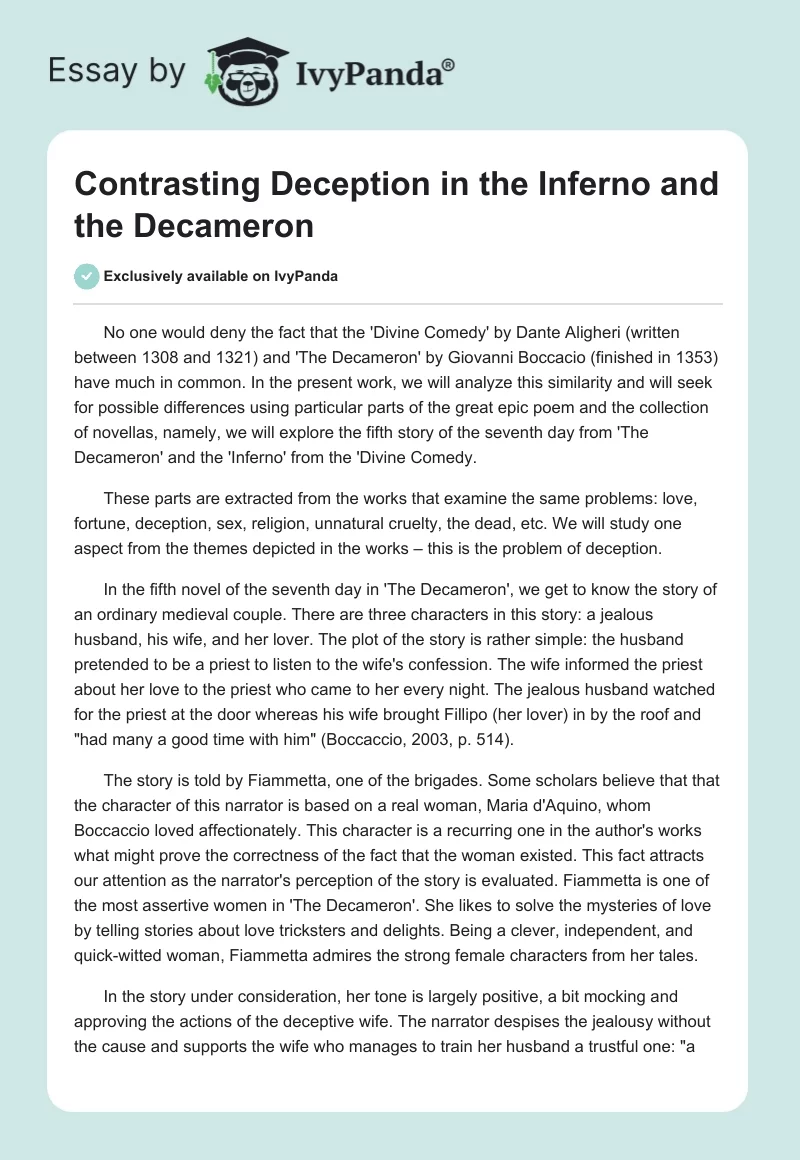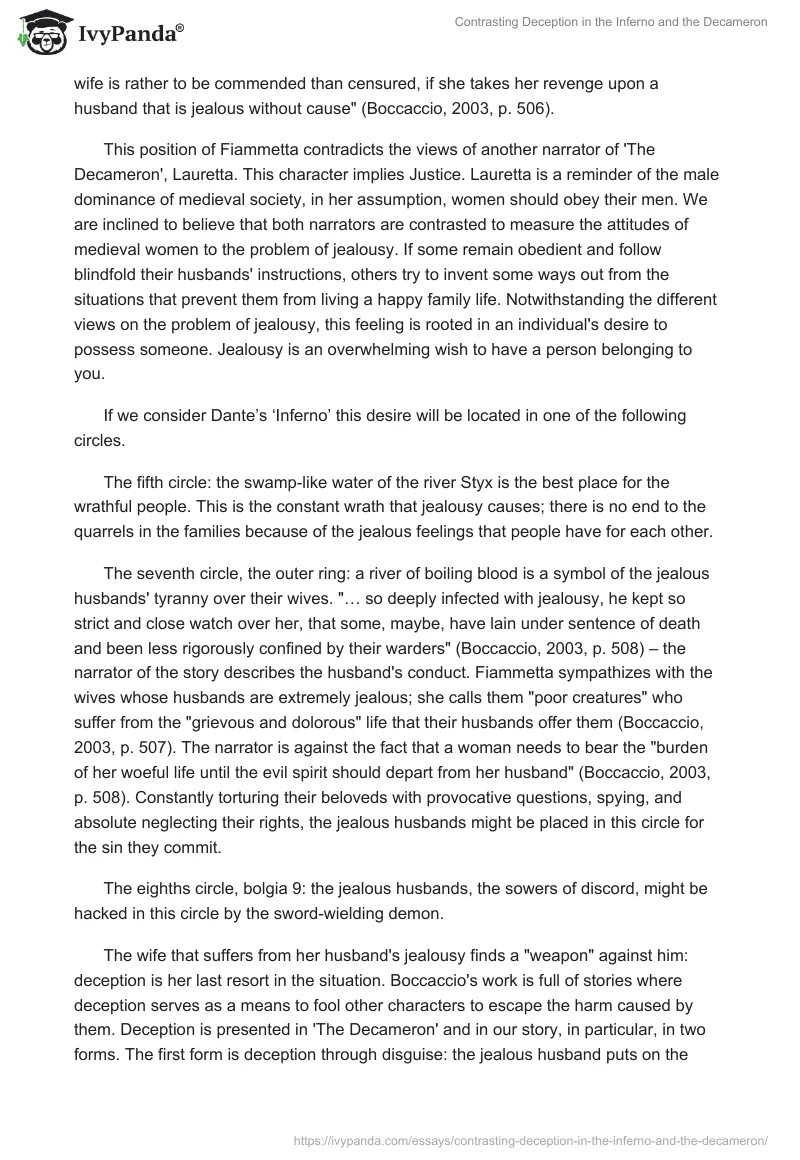No one would deny the fact that the ‘Divine Comedy’ by Dante Aligheri (written between 1308 and 1321) and ‘The Decameron’ by Giovanni Boccacio (finished in 1353) have much in common. In the present work, we will analyze this similarity and will seek for possible differences using particular parts of the great epic poem and the collection of novellas, namely, we will explore the fifth story of the seventh day from ‘The Decameron’ and the ‘Inferno’ from the ‘Divine Comedy.
These parts are extracted from the works that examine the same problems: love, fortune, deception, sex, religion, unnatural cruelty, the dead, etc. We will study one aspect from the themes depicted in the works – this is the problem of deception.
In the fifth novel of the seventh day in ‘The Decameron’, we get to know the story of an ordinary medieval couple. There are three characters in this story: a jealous husband, his wife, and her lover. The plot of the story is rather simple: the husband pretended to be a priest to listen to the wife’s confession. The wife informed the priest about her love to the priest who came to her every night. The jealous husband watched for the priest at the door whereas his wife brought Fillipo (her lover) in by the roof and “had many a good time with him” (Boccaccio, 2003, p. 514).
The story is told by Fiammetta, one of the brigades. Some scholars believe that that the character of this narrator is based on a real woman, Maria d’Aquino, whom Boccaccio loved affectionately. This character is a recurring one in the author’s works what might prove the correctness of the fact that the woman existed. This fact attracts our attention as the narrator’s perception of the story is evaluated. Fiammetta is one of the most assertive women in ‘The Decameron’. She likes to solve the mysteries of love by telling stories about love tricksters and delights. Being a clever, independent, and quick-witted woman, Fiammetta admires the strong female characters from her tales.
In the story under consideration, her tone is largely positive, a bit mocking and approving the actions of the deceptive wife. The narrator despises the jealousy without the cause and supports the wife who manages to train her husband a trustful one: “a wife is rather to be commended than censured, if she takes her revenge upon a husband that is jealous without cause” (Boccaccio, 2003, p. 506).
This position of Fiammetta contradicts the views of another narrator of ‘The Decameron’, Lauretta. This character implies Justice. Lauretta is a reminder of the male dominance of medieval society, in her assumption, women should obey their men. We are inclined to believe that both narrators are contrasted to measure the attitudes of medieval women to the problem of jealousy. If some remain obedient and follow blindfold their husbands’ instructions, others try to invent some ways out from the situations that prevent them from living a happy family life. Notwithstanding the different views on the problem of jealousy, this feeling is rooted in an individual’s desire to possess someone. Jealousy is an overwhelming wish to have a person belonging to you.
If we consider Dante’s ‘Inferno’ this desire will be located in one of the following circles.
The fifth circle: the swamp-like water of the river Styx is the best place for the wrathful people. This is the constant wrath that jealousy causes; there is no end to the quarrels in the families because of the jealous feelings that people have for each other.
The seventh circle, the outer ring: a river of boiling blood is a symbol of the jealous husbands’ tyranny over their wives. “… so deeply infected with jealousy, he kept so strict and close watch over her, that some, maybe, have lain under sentence of death and been less rigorously confined by their warders” (Boccaccio, 2003, p. 508) – the narrator of the story describes the husband’s conduct. Fiammetta sympathizes with the wives whose husbands are extremely jealous; she calls them “poor creatures” who suffer from the “grievous and dolorous” life that their husbands offer them (Boccaccio, 2003, p. 507). The narrator is against the fact that a woman needs to bear the “burden of her woeful life until the evil spirit should depart from her husband” (Boccaccio, 2003, p. 508). Constantly torturing their beloveds with provocative questions, spying, and absolute neglecting their rights, the jealous husbands might be placed in this circle for the sin they commit.
The eighths circle, bolgia 9: the jealous husbands, the sowers of discord, might be hacked in this circle by the sword-wielding demon.
The wife that suffers from her husband’s jealousy finds a “weapon” against him: deception is her last resort in the situation. Boccaccio’s work is full of stories where deception serves as a means to fool other characters to escape the harm caused by them. Deception is presented in ‘The Decameron’ and in our story, in particular, in two forms. The first form is deception through disguise: the jealous husband puts on the clothes of a priest to listen to the confession of his wife: “he forthwith put on one of the priest’s robes with a great hood, overshadowing the face, such as we see priests wear, and which he pulled somewhat forward” (Boccaccio, 2003, p. 511). The second form is deception through the use of language: the woman from the story deceives her husband to be with her lover.
According to Dante’s concept of Hell, the sin of deception that is depicted in the seventh day novel of ‘The Decameron’ may be placed in one of the following circles.
The second circle: those who deceive others because of the overwhelming desire for sexual pleasure should be punished here. People who are overcome by lust are the first ones to be truly punished in Dante’s Hell. The soul of the deceiving wife will be blown about to and fro by the fierce storm, without any hope to get out from it. The storm serves as a symbol of the power of lust that the wife is consumed with.
The eighth circle, bolgia 6: the wife deserves this circle because of her being hypocritical towards her husband. Since then she will join the Hypocrites depicted by Dante. They are listlessly walking along having gold-gilded lead cloaks on. It is interesting to admit that the wife and the husband from our story can meet in this circle as both of them fail to be honest with each other.
The ninth circle, zone 1: because of the wife’s betrayal she is considered to be a traitor to her husband. Her destiny is to be frozen in a lake of ice known as Cocytus. The soul of the traitor who appeared in this zone is immersed in the ice up to his or her neck.
As we can see the ‘Inferno’ may serve as an integral part of ‘The Decameron’. Both works are closely interconnected: the sins discussed in the first book are fairly punished in the second one. The study of both works proves that the sins one commits will be punished one day. The ‘Inferno’ and ‘The Decameron’ convince the reader that sinners receive appropriate punishment in perfect proportion to their sin. The works make the reader consider one’s way of life and make soul-searching with the corresponding consequences.
References
- Alighieri, D. (1996). The Divine Comedy of Dante Alighieri (R. M. Durling, Ed.) (Durling, R. M., Trans.) (Vol. 1). New York: Oxford University Press.
- Boccaccio G. (2003). The Decameron. Pengium Classics.


